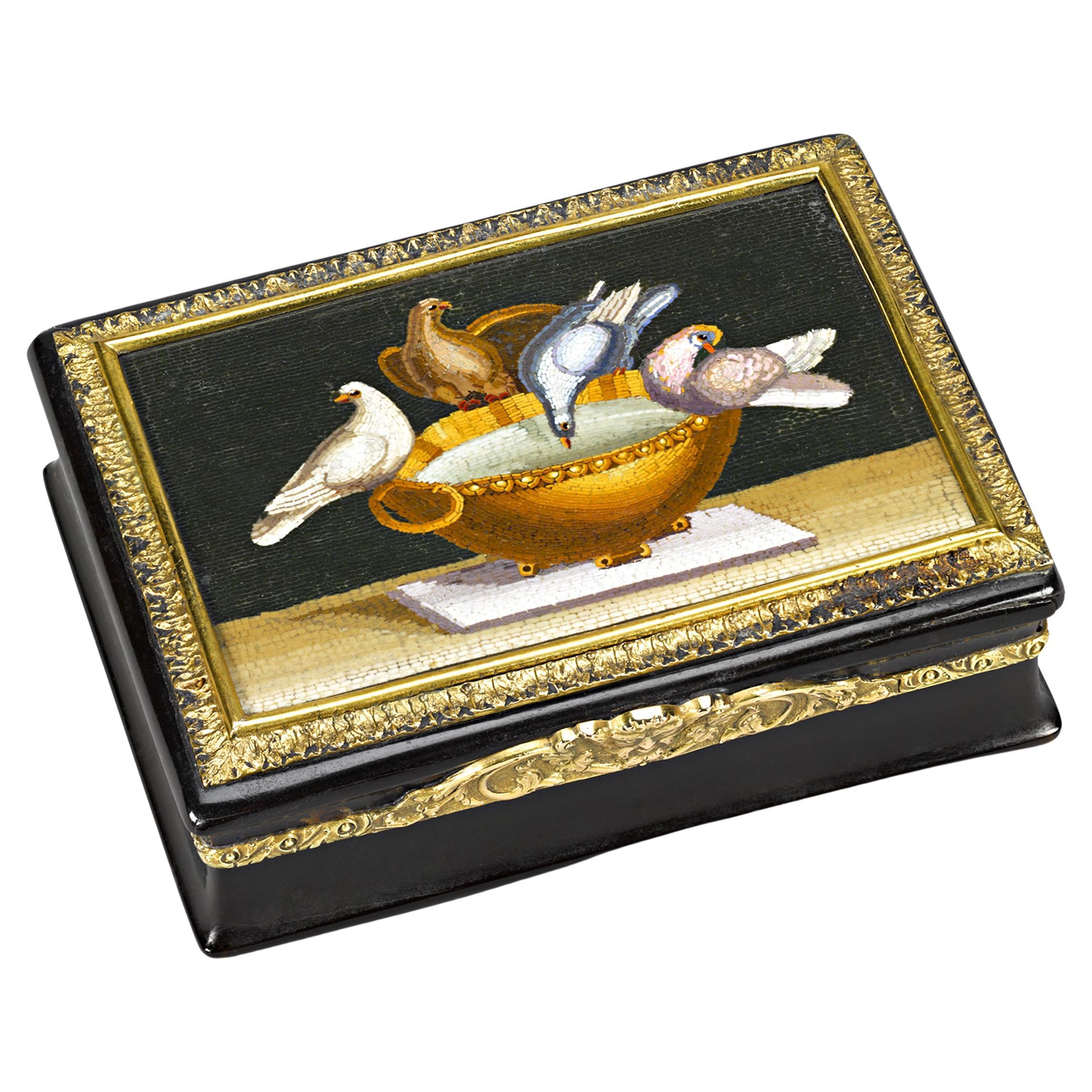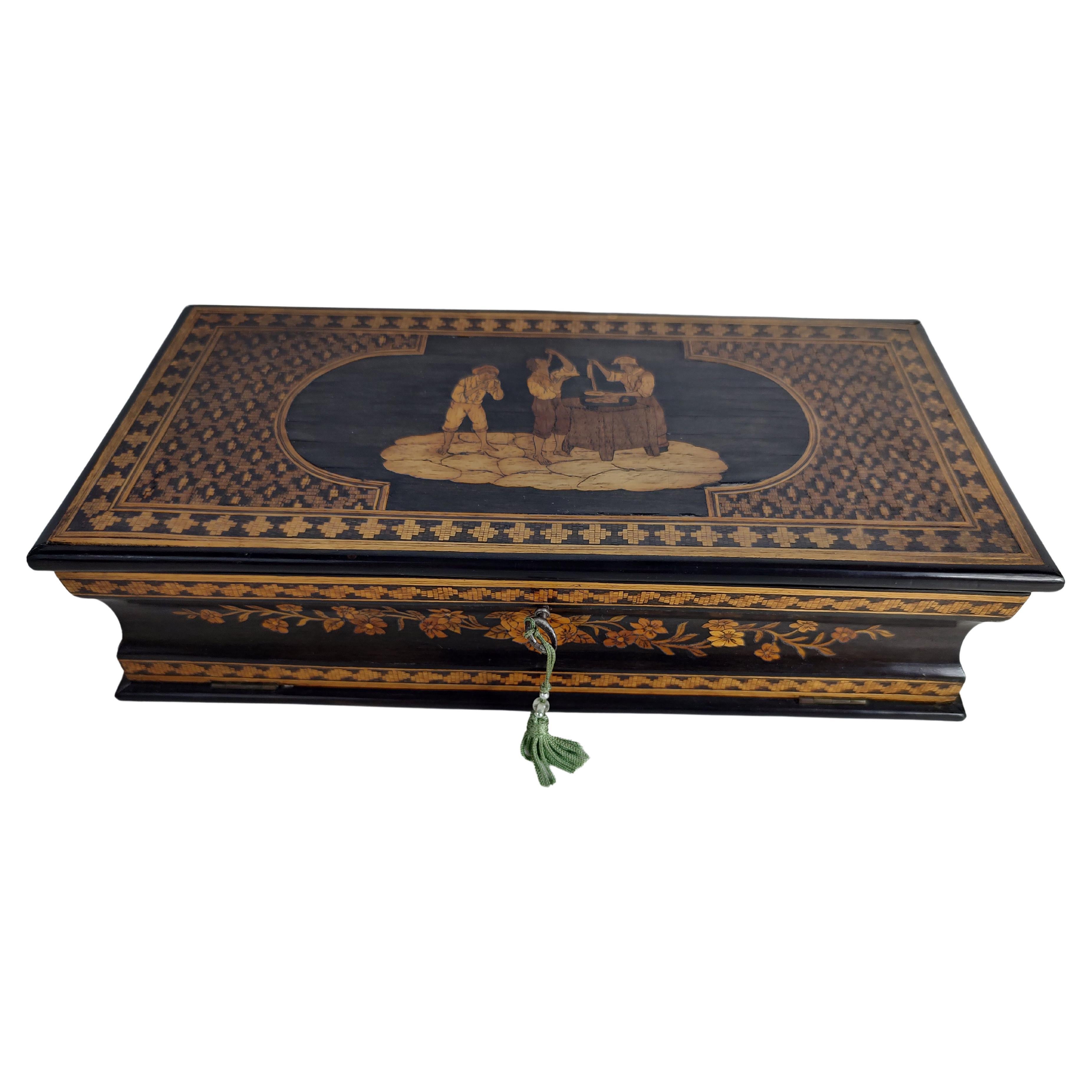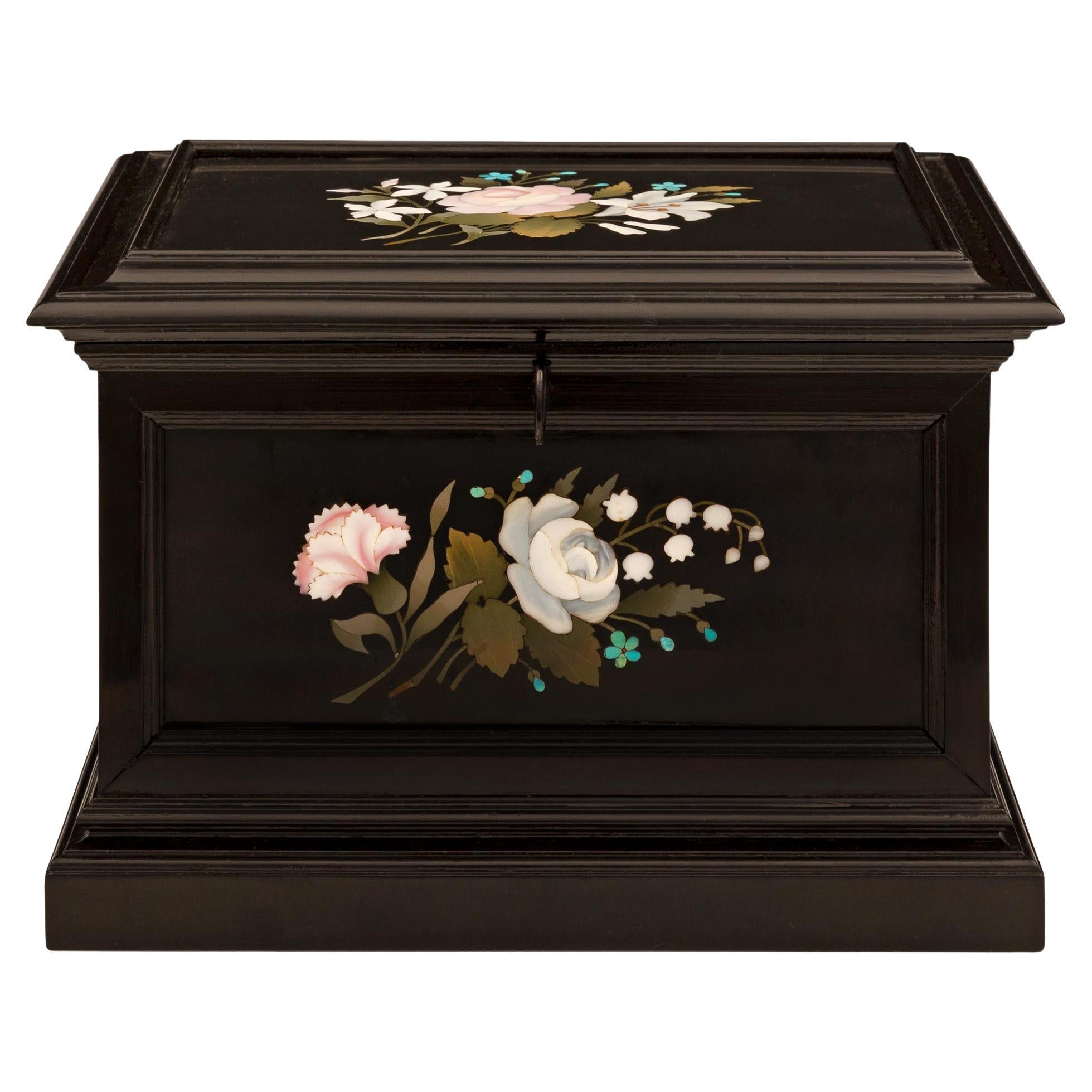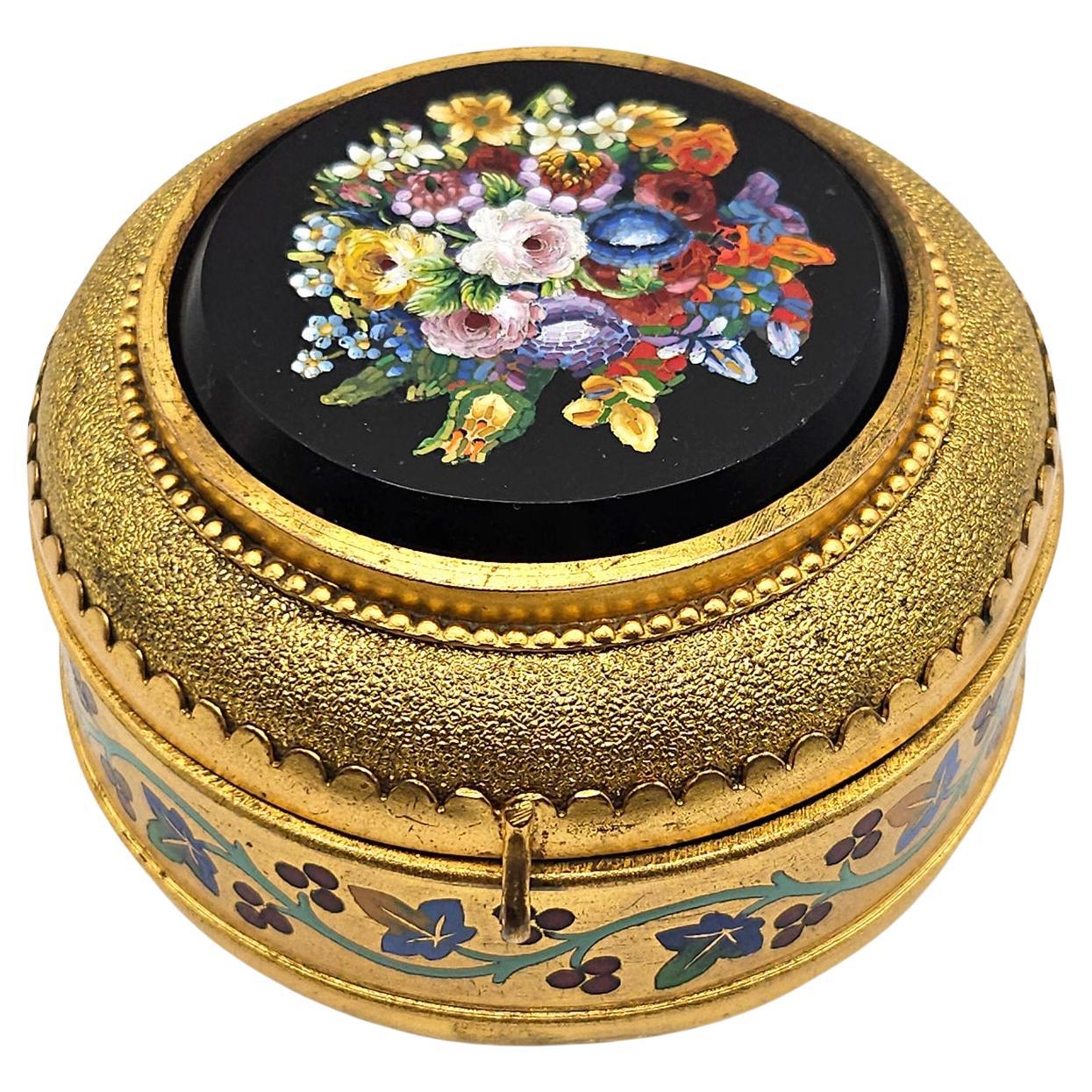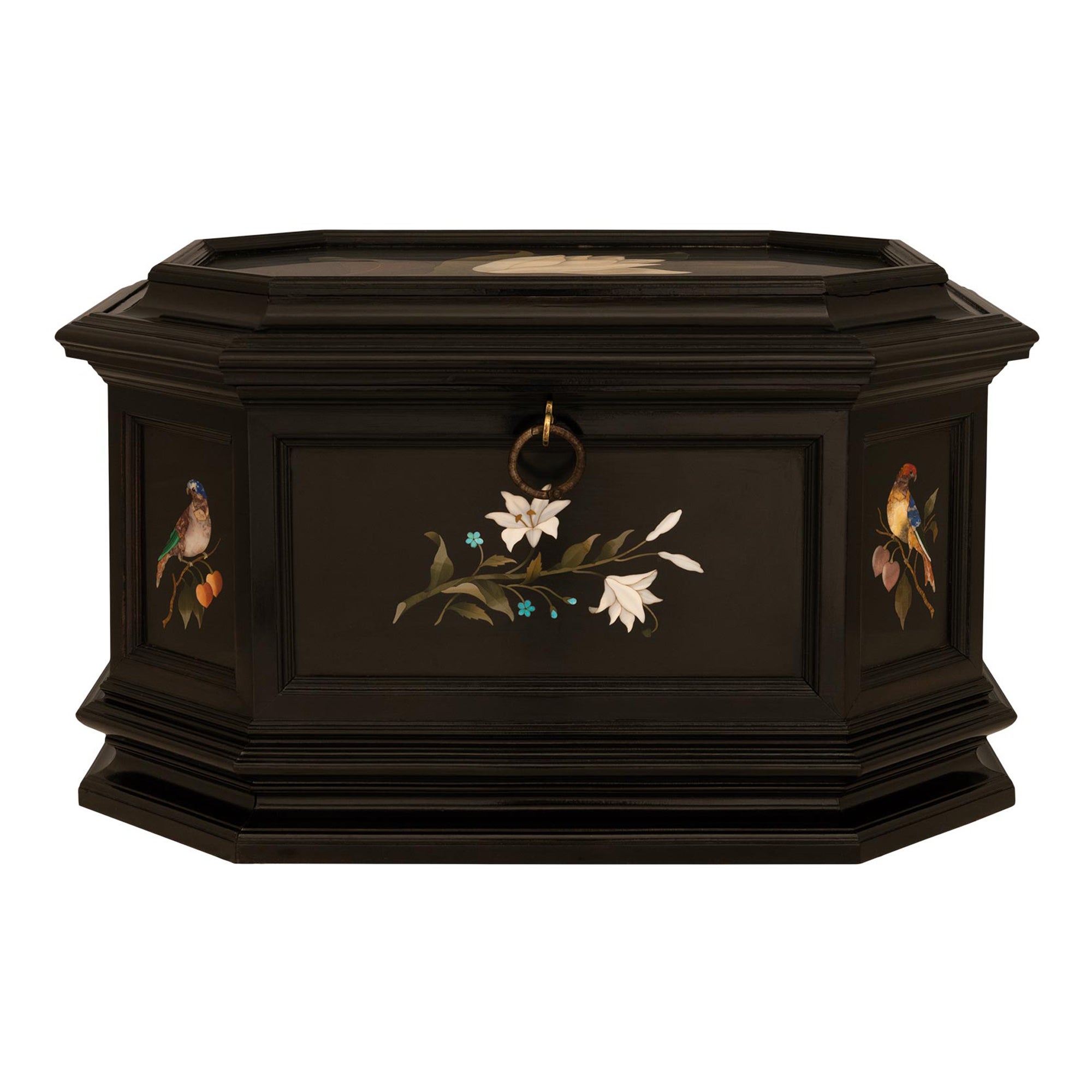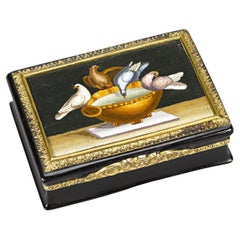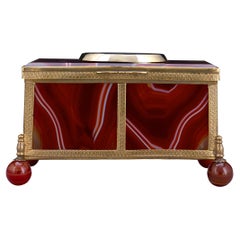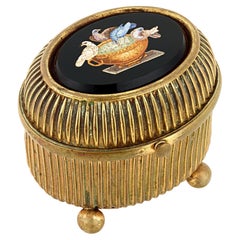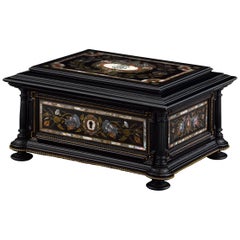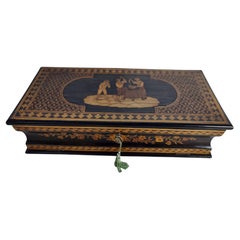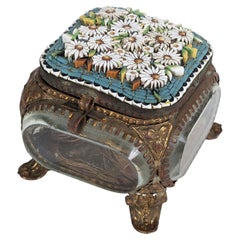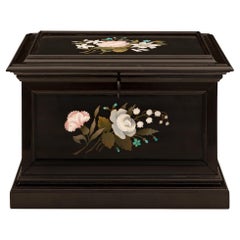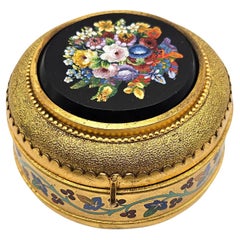Items Similar to Micromosaic and Pietre Dure Grand Tour Casket
Want more images or videos?
Request additional images or videos from the seller
1 of 6
Micromosaic and Pietre Dure Grand Tour Casket
$34,500
£26,263.14
€30,024.32
CA$48,541.97
A$53,096.92
CHF 27,956.98
MX$633,923.22
NOK 356,315.71
SEK 325,943.86
DKK 224,250.91
About the Item
The time-honored decorative techniques of pietre dure and micromosaic are combined in this rare and exceptionally-crafted Grand Tour casket. Serving as a memento of this once-requisite rite of passage for young gentlemen of the upper class, this large ebonized wood casket features five resplendent micromosaic plaques on the lid, each recreating some of the most historic monuments of ancient Rome, including the Temple of Vespasian, the Pantheon and the Colosseum, with outstanding intricacy. Bursting forth with color and incredible artistry is the hardstone pietre dure relief work depicting ribbon-tied boughs of lush fruit and leaves. Highlighting this assemblage of creative skill are wonderfully chiseled gilt bronze mounts that draw the eye to the magnificent workmanship imparted upon this exquisite objet d'art.
Wealthy aristocrats making their Grand Tour through Italy were very fond of pietre dure and micromosaic works. These techniques were expensive, requiring not only precious materials but highly skilled craftsmen. Authentic hardstone pietre dure and micromosaic works such as this are very rare and were available only to the wealthiest European tourists and to wealthy Italian royals. The techniques were rarely applied to a single work simultaneously, as demonstrated by this casket, making it an incredible specimen of Italian decorative art,
circa 1850.
Measures: 8 7/8" wide x 7 5/16" deep x 5 3/4" high.
- Dimensions:Height: 5.75 in (14.61 cm)Width: 8.88 in (22.56 cm)Depth: 7.32 in (18.6 cm)
- Style:Greco Roman (In the Style Of)
- Materials and Techniques:
- Place of Origin:
- Period:
- Date of Manufacture:circa 1850
- Condition:
- Seller Location:New Orleans, LA
- Reference Number:Seller: 30-79021stDibs: LU891113157811
About the Seller
5.0
Recognized Seller
These prestigious sellers are industry leaders and represent the highest echelon for item quality and design.
Established in 1912
1stDibs seller since 2010
114 sales on 1stDibs
Typical response time: 4 hours
- ShippingRetrieving quote...Shipping from: New Orleans, LA
- Return Policy
More From This Seller
View AllMicromosaic Snuff Box
Located in New Orleans, LA
This exceptional micromosaic snuff box represents the heights of this ancient art form. Depicting four doves sitting atop a bronze dish, the inse...
Category
Antique 19th Century Neoclassical Snuff Boxes and Tobacco Boxes
Materials
Bronze
$34,200
Agate and Micromosaic Box
Located in New Orleans, LA
Intricate and flawless, the highly detailed micromosaic medallion on the lid of this agate box is an incredible example of this diminutive art form. The elaborate micromosaic depicts...
Category
Antique 19th Century European Other Decorative Boxes
Materials
Agate
$15,420
Pliny's Doves Micromosaic Box
Located in New Orleans, LA
This exquisite doré bronze box, featuring a meticulously crafted micromosaic lid, embodies the pinnacle of 19th-century Italian artistry. The centerpie...
Category
Antique 19th Century Italian Neoclassical Decorative Boxes
Materials
Bronze
Musical Jewelry and Sewing Casket
Located in New Orleans, LA
This charming musical jewelry and sewing box is a work of sublime artistry. Almost certainly German or Austrian in origin and crafted of deep, ebonized...
Category
Early 20th Century Austrian Other Decorative Boxes
Materials
Multi-gemstone
French Limoges Enamel Box
By Limoges
Located in New Orleans, LA
This delightful porcelain and enamel box perfectly exemplifies the esteemed French Limoges tradition. It features a meticulously hand-applied pink and blue floral scene against a bro...
Category
Antique 19th Century French Decorative Boxes
Materials
Enamel
Swiss Gold and Enamel Musical Vinaigrette
Located in New Orleans, LA
A musical movement distinguishes this wonderful early 19th-century gold vinaigrette box. The vessel is covered in delicate engraving highlighted by bl...
Category
Antique 19th Century Swiss Neoclassical Decorative Boxes
Materials
Metal
You May Also Like
19th Century Mosaic Inlaid Marquetry Jewelry Box Sorrento Napoli, C1880
Located in Port Jervis, NY
Amazing Marquetry and inlay on this Sorrento Napoli Box C1880. There is craftsmanship of the highest caliber all over this box. Box front drops down to reveal inside completely cover...
Category
Antique 1880s Italian Baroque Jewelry Boxes
Materials
Brass
Micromosaic Grand Tour Jewel Casket
Located in Riverdale, NY
Micromosaic Grand Tour Jewel Casket from the late 19th Century. Elaborate inlaid floral tessarae of daisies cover the lid of the jewel-trinket box with glass panels on each side. All...
Category
Antique 1880s Italian Late Victorian Decorative Boxes
Materials
Brass
Italian 19th Century Florentine St. Ebony and Pietra Dura Marble Box
Located in West Palm Beach, FL
A charming and extremely decorative Italian 19th century Florentine st. Ebony and Pietra Dura marble box. The box is raised by an elegant stepped mottled base with striking wonderful...
Category
Antique 19th Century Italian Decorative Boxes
Materials
Marble
Antique Grand Tour Micro Mosaic Jewelry Box by Cesare Roccheggiani, Rome c. 1875
By Cesare Roccheggiani
Located in London, GB
A highly attractive and rare floral Grand Tour micromosaic jewelry or trinket box made by Cesare Roccheggiani in Rome, Italy, c. 1875.
This is a beautifully detailed micro-mosaic box. The panel in the lid depicts a lush bouquet of spring flowers, including roses, forget-me-nots, daffodils, buttercups and crocus, amongst others. These are described in brightly coloured stone micromosaic inlaid into a black surround, lending the piece wonderful contrast.
The more common subjects for similar micro mosaic boxes are architectural views of Rome; floral examples such as this are much harder to find.
The panel is mounted in a box gilded in 24 carat gold. Another distinctive feature is the granulated finish around the lid and to the underside of the box: it is most unusual and lends the piece a lovely texture.
A hand-painted champlevé enamel frieze wraps around the central body of the gilt metal box, depicting scrolling turquoise vines blooming with red berries along with blue, green and yellow vine leaves.
The interior is lined in the original silk and in very good original condition. The maker’s name ‘C. ROCCHEGGIANI ROMA’ is emblazoned in gold to the interior of the lid beneath the motif of a cross surmounted by a crown. The lining of both the lid and body are bordered with a ropetwist detail. The lid closes with hooked clasp, and the hinge is in good condition.
Cesare Roccheggiani was one of the most successful mosaicists in the late 19th century in Rome. He probably worked in Michelangelo Barberi’s workshop, and was in all likelihood related to Lorenzo Roccheggiani, a late eighteenth-century master mosaicist at the Vatican whose work included the altarpiece, Crucifixion of St. Peter after Guido Reni, and Nicolo Roccheggiani who worked on the Achilles Shield tabletop commissioned by Napoleon Bonaparte, and later gifted to Charles X of France, now in the collection of the Louvre.
Cesare Roccheggiani opened his premises on Via Condotti in Rome in 1874, and ran a production workshop including mosaicists, goldsmiths and other craftsmen. He was renowned as a source for fine quality Grand Tour mosaics...
Category
Antique Mid-19th Century Italian Grand Tour Jewelry Boxes
Materials
Stone, Metal
Italian 19th Century Florentine St. Ebony And Pietra Dura Marble Box
Located in West Palm Beach, FL
A charming and very elegant Italian 19th century Florentine st. Ebony and Pietra Dura marble box. The octagonal box is raised by an elegant stepped mottled base with highly detailed ...
Category
Antique 19th Century Italian Decorative Boxes
Materials
Marble
Italian Tortoiseshell & Enamel Dresser Box
Located in Bradenton, FL
Late 19th / early 20th Century Italian trinket/dresser box. Box features embossed brass frame with tortoiseshell panels. Hinged lid with inset outdoor...
Category
Antique Late 19th Century Italian Neoclassical Decorative Boxes
Materials
Brass, Enamel
